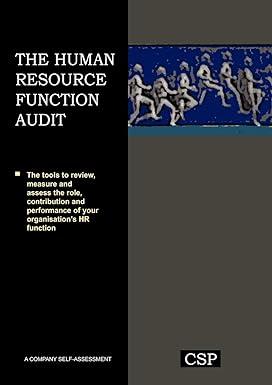Question
A manufacturing firm employs a CEO that experiences a 3/4 probability of successfully generating $10 million in revenue if she works hard. She only generates
A manufacturing firm employs a CEO that experiences a 3/4 probability of successfully generating $10 million in revenue if she works hard. She only generates $1 million in revenue for her company with a probability of 1/4 if she works hard and loses the case. Alternatively, if this CEO does not work hard she only has a 1/4 probability of successfully generating $10 million in revenue. She experiences a 3/4 probability of only generating $1 million if she does not work hard. This CEO experiences costs of $250,000 if she works hard and costs of $150,000 if she does not. While she knows if shes working hard, her company can not determine whether she is working hard when she is successful or when she fails.
a.) If the manufacturing company pays this CEO $150,000 above the market rate of $400,000 whether she succeeds or fails, will she have incentive to work hard? Explain.
b.) What is the CEOs net earnings at this pay level?
c.) What is the company's expected profit for this situation?
Suppose now that the company would like to induce this employee to work harder because doing so increases the firms expected profits. The firm considers paying different salaries based on the success or failure of the case. Equation-1 depicts the combination of payments required to cover the sum of the salary the CEO could receive from working hard at the market rate and the cost borne from working hard for this case.
3/4(Ws) + 1/4(Wf) = $250,000 + $400,000=$650,000 (1)
where Ws and Wf , respectively represent the wage payments to the CEO if she succeeds or if she fails, and the probability of success or failure is 3/4 and 1/4, respectively. The product of each probability and the associated wage payment depicts the CEOs expected payment for success or failure. The sum of these products depicts the CEOs total expected payment.
d.) What is the equation that depicts the combination of payments required to cover the salary the CEO could receive at the market rate and the cost borne if she does not work hard?
e.) What is the equation that depicts the combination of payments guaranteeing that the CEO will receive more from working hard than from shirking?
f.) Use equation-1 and the equation derived in problem 2e to determine the separate wages that the manufacturing company should pay to offset the CEOs cost of working hard and to guarantee that she will receive more from working hard than from shirking? (Note these separate wage payments should represent the minimum payments needed to satisfy the conditions presented in this problem).
g.) Does the expected profit derived from adopting the differential pay scheme exceed the expected profit derived from paying the same salary?
Step by Step Solution
There are 3 Steps involved in it
Step: 1

Get Instant Access to Expert-Tailored Solutions
See step-by-step solutions with expert insights and AI powered tools for academic success
Step: 2

Step: 3

Ace Your Homework with AI
Get the answers you need in no time with our AI-driven, step-by-step assistance
Get Started


